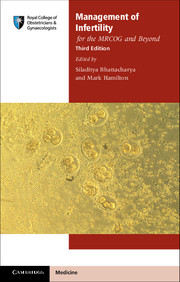Book contents
- Frontmatter
- Contents
- About the authors
- Preface
- Acknowledgements
- Abbreviations
- 1 Epidemiology and initial assessment
- 2 Male factor infertility
- 3 Ovulatory disorders
- 4 Tubal infertility
- 5 Endometriosis-related infertility
- 6 Uterine factors in infertility
- 7 Unexplained infertility
- 8 Assisted reproduction – preparation and work-up of couples
- 9 Assisted reproduction – clinical and laboratory procedures
- Index
5 - Endometriosis-related infertility
Published online by Cambridge University Press: 05 June 2014
- Frontmatter
- Contents
- About the authors
- Preface
- Acknowledgements
- Abbreviations
- 1 Epidemiology and initial assessment
- 2 Male factor infertility
- 3 Ovulatory disorders
- 4 Tubal infertility
- 5 Endometriosis-related infertility
- 6 Uterine factors in infertility
- 7 Unexplained infertility
- 8 Assisted reproduction – preparation and work-up of couples
- 9 Assisted reproduction – clinical and laboratory procedures
- Index
Summary
Introduction
Endometriosis causes pain and infertility for millions of women worldwide. Although first reported by Rokitansky 150 years ago, debate continues over its aetiology, pathogenesis and most effective treatment.
Aetiology
Endometriosis may be defined as the presence and proliferation of endometrial-like tissue outside the uterus, primarily on the pelvic peritoneum, ovaries and rectovaginal septum. The prevalence (proportion of women with the disease at any one time) of endometriosis is 6–10% in women of reproductive age, and 30–50% of women with pelvic pain and/or infertility.
The most widely accepted theory of pathogenesis is Sampson's ‘transplantation theory’. Sampson proposed that retrograde flow of endometrial cells from the uterine cavity, through the fallopian tubes, into the pelvic cavity during menstruation deposits viable tissue that implants on the peritoneal surface. This theory is supported by data showing an increased occurrence of endometriosis in women with müllerian duct anomalies causing genital outflow tract obstruction leading to increased retrograde menstruation. Women who menstruate more frequently, more heavily or for a longer duration, and therefore have increased exposure to retrograde menstruation, also have a higher risk of developing the disease. Additional risk factors include prolonged exposure to estrogen (such as in early menarche and late menopause), obesity, low birthweight and exposure to endocrine-disrupting chemicals. Twin and family studies suggest a genetic component. Prolonged breastfeeding and higher numbers of pregnancies are protective.
Although 90% of women have retrograde flow during menses, only 6–10% develop endometriosis.
Keywords
- Type
- Chapter
- Information
- Management of Infertility for the MRCOG and Beyond , pp. 57 - 66Publisher: Cambridge University PressPrint publication year: 2014

